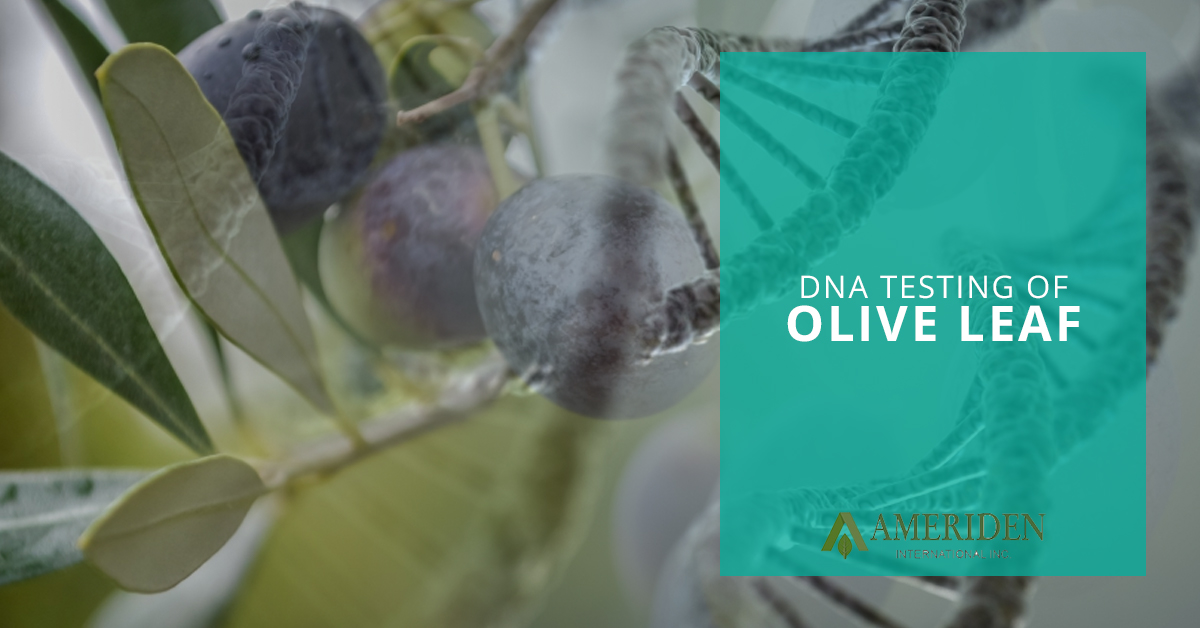DNA Testing of the Olive Leaf
Posted by Ameriden International on 23rd Jun 2017

DNA Testing of the Olive Leaf
In 2015, the New York Attorney General claimed that some dietary supplements that were collected and DNA-tested did not contain what was claimed on their labels. It has caused a large stir in the natural products & supplement industry. However, DNA testing is not a recommended determination for plant identification, potency or safety at the supplement level. While DNA testing is not the proper test for most finished products, it is applicable at the raw product stage to determine species. Also, DNA analysis enables genotype fingerprinting with consequent identification of different organisms, thus allowing traceability along the food chain.1 Indeed, this technique can have interesting applications in the agro-food industry for the identification of species and cultivars of both raw materials and processed food, particularly when a protected designation of origin (PDO) has been assigned.
DNA markers have been used for identification of olive cultivars, being independent from environmental fluctuations and on account of the high degree of polymorphism, which allows to effectively distinguish very similar cultivars and to solve homonymy cases.
We at Ameriden want to be proactive in this endeavor and provide our customers the most up-to-date information available. So as a complementary test to our already established pre and finish product testing regime, we have our raw olive leaf DNA-tested.
DNA Can Help Establish the Chemotype.
Just as in humans, each plant has a specific chemotype. The chemotype is a chemically- distinct entity in a plant or microorganism of the species which has traditionally been defined in natural products by its genetic constitution, or DNA sequence. However, with the development of DNA sequencing methods and the discovery of the polymerase chain reaction (PCR) for DNA amplification, DNA sequence analysis has been illuminated. The genotypes identified by PCR amplification now suffice to predict the species of plants in a greater depth.
With PCR amplification and subsequent restriction analysis of the olive leaf to the matrix of the leaf region spacers (ITS1 and ITS2) and the 5.8S rRNA gene, identification of olive leaf, belonging to the genus Olea europaea L. is certain. This methodology has previously been used for the identification of other species of this genus, but in this present testing, the application has been applied just to the identification of the genus Olea europaea L. with special interest in clinical and biotechnology.
There are many species and cultivars among the genus Olea europaea L. This test has been performed to identify that the current leaf is of this genus and subspecies europaea. Variability was observed both in the length of the amplified region (ranging between 215 and 350 bp) and in restriction patterns, allowing for unequivocal identification of the species level (Olea europaea L.) and does not include other subspecies such as Ogliarola leccese, Canino, Frantoio, cuspidata, guanchica, cerasiformis, maroccana or laperrinei.
To determine the other subspecies would require sequencing of the D1/D2 domain of the 26S rRNA gene or the 5.8S-ITS region for their specific length of the amplified region and proper subspecies differentiation.
The main purpose of this testing was to determine the ID for Olea europaea L subspecies as well as contribute more information to the global plant databases. Also, this testing helps to facilitate fast reliable identification of a species in the future.
Olea is a genus of about 40 species in the family Oleaceae, found throughout the world. For humans, the most important species is by far the Olive (Olea europaea), native to the Mediterranean region, Africa, southwest Asia and the Himalayas. The identification of the Olea europaea L. species still largely relies on phenotype-based methods. There is a need for a molecular diagnostic approach that would allow groups to reliably discriminate between the different Olea subfamilies. The aim of this test once again was to apply sequence analysis of its partial 28S rRNA gene for species identification of the Olea europaea L. clinical isolates.
Although the method employed did reveal some genetic polymorphism among Olea europaea member isolates tested, to determine the subvariety of L., it was not enough for complete species delineation (other cultivars). For this to be achieved, other genetic loci, within and beyond the rDNA operon, need to be investigated. A polymorphic genetic map would allow the different strains to be distinguished genetically. The more detailed the linkage map, the better the mapping resolution will become.
In addition to genetic taxonomy, DNA testing and other classical morphological and non-morphological methods such as phytochemical taxonomy can also provide supplementary information in species identification for the future.
In summary: The DNA testing undertaken by ABC Testing shows that the sample of Olive Leaf to be that of Olea europaea L. with its sequence producing significant alignment and a query length at 216. This differentiates it from any other species variety based on its region spacers (ITS1 and ITS2) and the 5.8S rRNA gene. This information also improves all online databases available by unveiling the distinct numerical value.
References
The chemotaxonomic classification of Olea and its correlation with morphological characteristics and genetic taxonomy
http://onlinelibrary.wiley.com/doi/10.1111/j.1095-8339.1980.tb00946.x/abstract
The Phylogenetic Potential of Entire 26S rDNA Sequences in Plants
http://mbe.oxfordjournals.org/content/15/3/251.full.pdf
Selective recognition of DNA from olive leaves and olive oil by PNA and modified-PNA microarrays
http://www.ncbi.nlm.nih.gov/pmc/articles/PMC3429532/#R1
Olea europaea DNA Bar Coding
https://www.infona.pl/resource/bwmeta1.element.elsevier-c4acd676-e5b0-3d4f-b2eb-80bff7efe8d4
DNA Based Tests for Olea europaea
http://bmcplantbiol.biomedcentral.com/articles/10.1186/1471-2229-10-211


